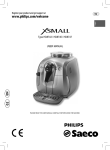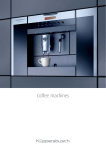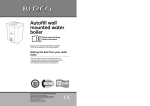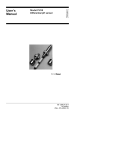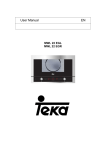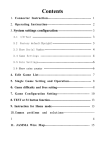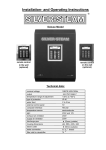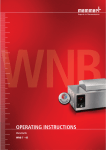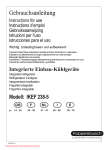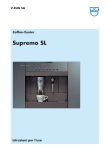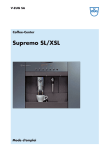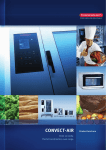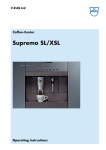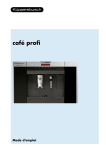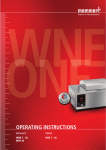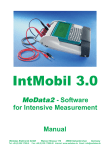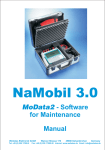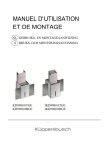Download Built-in fully-automatic coffee machine - General
Transcript
Built-in fully-automatic coffee machine EKV 6600.0 Service Manual: H6-72-01 Responsible: Email: Tel.: Fax: Date: Mario Kühne [email protected] (0209) 401-756 (0209) 401-743 21.12.06 KÜPPERSBUSCH HAUSGERÄTE AG Kundendienst Postfach 100 132 45801 Gelsenkirchen 3 Contents 1. Safety ............................................................................................................................... 5 2. Safety instructions ......................................................................................................... 6 3. Your appliance at a glance ............................................................................................ 7 4. Technical data................................................................................................................. 9 4.1 5. Installation..................................................................................................................... 10 5.1 5.2 5.3 5.4 6. General.................................................................................................................. 9 Instructions for installation ................................................................................... 10 EKV 6600.0 installation dimensions ................................................................... 10 Installation in a top unit ....................................................................................... 11 Installation in a tall unit ....................................................................................... 11 Button assignments ..................................................................................................... 13 6.1 6.2 Pre-set button assignment .................................................................................. 13 Button assignment in the programming mode..................................................... 13 7. User settings ................................................................................................................. 14 8. Fittings........................................................................................................................... 16 8.1 8.2 8.3 8.4 8.5 8.6 9. Aroma Control ..................................................................................................... 16 Water tank ........................................................................................................... 16 Grinder ................................................................................................................ 17 Brewing unit......................................................................................................... 17 Two separate heating systems............................................................................ 17 Accessories ......................................................................................................... 17 AquaPrima water filter ................................................................................................. 18 9.1 9.2 Operating principle .............................................................................................. 18 Inserting the AquaPrima water filter .................................................................... 19 10. Accessing individual components ............................................................................. 20 10.1 10.2 10.3 10.4 10.5 10.6 Coffee dispenser ................................................................................................. 21 Door lock ............................................................................................................. 22 AromaControl ...................................................................................................... 23 Flap support ........................................................................................................ 23 Hot water nozzle.................................................................................................. 24 Brewing unit sieve ............................................................................................... 25 11. Care and Maintenance ................................................................................................. 26 11.1 11.2 For internal use only Cleaning .............................................................................................................. 26 Descaling............................................................................................................. 28 4 12. What is to be done if … ................................................................................................ 30 12.1 12.2 12.3 12.4 12.5 12.6 12.7 12.8 12.9 12.10 12.11 12.12 … “Water tank empty“ is not shown? .................................................................. 30 … Ventilate “permanently“ is shown? .................................................................. 30 … Water is not dispensed or is dispensed with insufficient pressure? ................ 31 ... The drip tray drops down?............................................................................... 32 … Coffee bean box does not close? ................................................................... 32 … Coffee is not dispensed uniformly or is dispensed without flowing? ............... 32 ... Coffee tastes bitter? ........................................................................................ 33 ... Coffee tastes bland?........................................................................................ 33 ... Coffee tastes rancid?....................................................................................... 33 ... The coffee does not have a good crema? ....................................................... 33 … Faults develop during operation? ................................................................... 34 … The following messages are shown?.............................................................. 34 13. Test and diagnosis program........................................................................................ 35 13.1 13.2 Tests carried out on component and function ..................................................... 35 Testing the microswitch ....................................................................................... 37 14. Heating diagram............................................................................................................ 38 For internal use only 5 1. • • Safety Because of the universal cut-off device (relay and manometric switch), on measuring the connector plug in accordance with VDE 0701, the boiler must be tested for insulation faults by means of direct measurement, or the differential current of the appliance must be measured! Beware of the sharp edges of stainless steel units when replacing components. Risk of scalding! Water which is dispensed is very hot! Do not touch the outlet pipe! The boiler heats up to 98°C - 128°C during operation. For internal use only 6 2. Safety instructions • The appliance may only be connected to a suitable wall outlet. Do not remove the plug from the socket by pulling on the cable! Do not use any extension cables in wet rooms. • The power supply must correspond to the information on the nameplate. Recommendation: Connect the appliance via an F1 switch. • The appliance must be earthed for electrical safety reaons. The manufacturer will not be held liable for any damage cause by insufficient earthing of the appliance. • Connecting the appliance to the mains and repairing and servicing the appliance may only be carried out by a qualified electrician according to currently-valid safety regulations. For your own safety, do not allow anyone other than a qualified service technician to instal, service or repair this appliance. • The appliance may only be installed and connected to the mains and to a water supply in accordance with separate installation instructions. • Never expose the appliance to adverse weather conditions (rain, snow or frost) and do not operate it with wet hands. • When cleaning the appliance, carrying out repairs or replacing components, the appliance must be disconnected from the mains (switch off the fuse!). • Do not switch the appliance on until it has been installed! • The appliance is intended for making coffee, espresso and hot water, for frothing milk and for heating up beverages with steam for use in a home. In the case of inappropriate operation or incorrect handling, liability cannot be assumed for any resulting damage. • Never operate a defect appliance or an appliance with faulty cables. The manufacturer of the product will assume no liability whatsoever for consequences or damage resulting from faulty installation, insufficient maintenance or no maintenance at all. • Some of the parts, such as the water discharge pipe and the brewing unit, need to be heated up if the appliance is to operate properly. Caution, danger of scalding! • Please be careful when working with the hot water discharge pipe and the brewing unit: Do not hold your hand under these parts and wait until hot parts have cooled down. • The electric cable may not be replaced by the user. • Do not interrupt any cleaning process that has commenced, since residual cleaning agent may then remain in the inside of the brewing unit. • Only fill cold, clean tap water into the tank intended for this purpose; hot water and other liquids may damage the appliance. • Use fresh water every day in order to avoid bacteria from developing. • Empty the water tank and the coffee bean box if the appliance is not to be used for a long time. Empty the collecting bowl and the salt box and clean them. Switch off the appliance. • Only use original spare parts and attachments. • Only extinguish fire with carbon dioxide (CO2) • Do not switch the appliance on until it has been installed! • Do not, under any circumstances, use steam or pressure cleaning machines to clean the appliance! Damage caused to your appliance by cleaning it this way can make it lethally dangerous. • Do not insert anything into the appliance openings (Danger! Electric voltage!) For internal use only 7 3. Your appliance at a glance N O O S P Q N T R U V ¬ N O P Q R S T Bar handle to open the panel Clear text display Control panel Rotating knobs for aroma control Nozzle Service flap Coffee dispenser Drip tray U V M Box for coffee grounds Drip tray Display for drip tray For internal use only M 8 N O P Q R S Fittings N O P Q R S Red clear text display Box for coffee beans Water tank Main switch Adjusting the grinding setting Brewing unit The features • LED lighting • Central switch-off device • Adjustable coffee dispenser height • Electronic push buttons • Electronic clock with a minute minder • Pre-set time • Standby mode • Programming quantities for 3 different cup sizes • Dispensing 1 or 2 cups • Automatic cleaning and descaling program • Automatic rinse when switching the machine on and off For internal use only 9 4. Technical data 4.1 General This service manual serves the purpose of providing customer service technicians who already have the know-how required to repair coffee machines with specific information on the operating mode of the appliances indicated on the front page. Overall dimensions Height 38.0cm Width 59.6cm Depth 32.6cm Weight Niche dimensions (WxDxH) Connected load in KW Voltage (V) Fuse Connecting cable Ready to plug in 13kg 560 x 450 x 381mm 1250W 230V 50Hz 10A 1.20m Yes Components Removable water tank Coffe bean box Coffee grounds box Collecting bowl 1.7l 300g 12 units volumeter 0.8l Warning signals optical or acoustic Pumping capacity 15bar Grinder Height-adjustable coffee dispenser Lighting For internal use only Ceramic disk grinder 80-105mm rear 155mm 3 LED 10 5. Installation 5.1 Instructions for installation • Statutory regulations and the connection specifications issued by the local power supply company must be strictly observed. • Prior to connecting the appliance to the mains ensure that the power supply complies with that for which the appliance has been designed. • The appliance may not carry any current when it is being connected or when repairs are being carried out. Disconnect the fuse. • Full protection against accidental contact must be ensured on installation. • The appliance may only be connected to a properly-installed wall outlet. The connection cable should only be replaced by an electrician in observance of the relevant regulations. • Safety regulations require that an all-pole isolator with a contact opening of at least 3 mm be used on the installation side. • The built-in cabinet must be secured firmly to the floor and on the walls since the substantial weight of the cabinet may otherwise easily cause it to fall over. • The fully-automatic coffee machine must be installed at a safe distance from other sources of heat, such as other home appliances, in order to ensure that the temperature does not rise excessively. 5.2 EKV 6600.0 installation dimensions For internal use only 11 5.3 Installation in a top unit 5.4 Installation in a tall unit at least 570mm (without a front door at least 550mm) For internal use only 12 The height can possibly be regulated with the adjusting screw (clearances, flush mounting). For internal use only 13 6. Button assignments 6.1 Pre-set button assignment When the control panel has been opened up various beverages can be selected simply by pressing a button. The buttons have been assigned in the factory. The individual user settings can be set with the electronic push buttons. Pre-setting at the factory Descaling Programming, standby, user settings Dispensing 1 cup of coffee, large Dispensing 1 cup of coffee Dispensing 1 cup of espresso Dispensing hot water Dispensing steam Red clear text display 6.2 Button assignment in the programming mode In the programming mode (see the section on programming) four buttons have been assigned a second function. These functions are for going through all of the menu items: 1 START with button 2 CURSOR BUTTONS and ( and ) for selecting and confirming and for increasing/decreasing the settings. 3 CONFIRM with button 4 EXIT with button For internal use only 14 7. User settings 1. Start with P Exit with ESC 2. Select a function select confirm 3. Making settings select confirm exit Function Display Setting and display Standby standby The machine switches into the power-down mode at 3-4 W on - off Rinsing The cycle is automatically cleaned when the machine is switched on. Coffee is always made with fresh water. rinse Language Selecting a language on the clear text display. The following languages are available: German, French, English, Spanish and Dutch language Contrast contrast Lighting lighting Use ON or OFF to switch the lighting on or off water hardness There are 4 settings for the water hardness. water filter on off reset Water hardness Water filter A rinsing cycle is activated at a boiler temperature of below 40°C German - ENGLISH The contrast setting for the clear text display can be made in 10 stages. Water filter present (yes - no): is only set the first time the water filter is used. “Reset” will then need to be selected every time the filter is changed. Temperature temperature low medium high Choosing the temperature for making coffee. There is a choice of low (88°C), medium (90°C) and high (92°C). A cold cup will cool down coffee being poured into it by approx.10°C. The temperature of the water used for brewing the ground coffee powder should be between 88°C and 92°C. For internal use only 15 Function Aroma Espresso Display Setting and display AROMA ESPRESSO Choosing the quantity of ground coffee for espresso between 6.87, 8.5 and over 10g/s for 80 - 122 impulses. AROMA coffee Choosing the quantity of ground coffee between 1.3 and 1.5g/s for approx. 300 impulses of 100ml. each. AROMA coffee long Choosing the quantity of ground coffee for coffee long. Moisten the pump for 1.5 - 3seconds. Pre-brewing pre-brewing The coffee is firstly moistened. This allows the flavour to develop fully. When the setting is at “long“ the coffee will be pre-brewed for 4 seconds. Total coffee total coffee The total number of coffee portions being dispensed is shown. Aroma coffee Aroma coffee long Timer Timer machine off after xx xx Choice of time after which the machine will switch to the standby mode (pre-set at 3 hours). Timer Timer set „Timer has no function“ timer timer-time-switching times Setting whether the switch-on and switch-off times are to be activated. time xx - xx Set the time. on xx:xx switching times show the time of day off xx:xx Setting the switch-on and switch-off times. on off Fade the time in or out. Cleaning cycle Factory settings cleaning cycle factory settings The cleaning cycle serves to degrease the brewing unit. no yes Re-setting all of the settings to the as-delivered state. For internal use only 16 8. Fittings 8.1 Aroma Control Operation for standard grinder setting Aroma Control enables the machine to be set individually according to a customer's wishes, from American weak to Italian strong, simply by turning the aroma knob. Maximum setting – for a light coffee, café crème type Turn the aroma knob anti-clockwise until it stops • Fast brewing process • Good extraction of flavour • Low water pressure • Normal quantity of water Medium setting - for normal coffee, espresso type Aroma knob in the middle • Slow brewing process • Optimal extraction of flavour • Medium water pressure • Little water Minimum setting - for strong coffee, ristretto type Turn the aroma knob clockwise until it stops 8.2 • Slow brewing process • Optimal extraction of flavour • High water pressure • Little water Water tank The fully-automatic coffee machine has an integrated water tank which holds approximately 1.7 litres of water. The tank should be filled with fresh water at least once a day, since germs may develop in water which has been left standing. The water tank can easily be removed from the front when the flap panel has been opened up and it can then be filled through an opening which is covered with a spring lid. For internal use only 17 8.3 Grinder In order for the coffee beans to develop their full flavour to perfection, they must firstly be ground to just the right fineness. The excellent quality of the innovative ceramic grinder guarantees that you will be able to enjoy perfect coffee. The first-class grinder material has a very long useful life span and also enables coffee to be precisely dosed, ensuring that it is consistently ground. The grinder should not be set at too fine a setting, since this will make the coffee grounds very compact and reduce the flow. If possible do not reset the grinder; leave it at the factory setting of "5". No coffee beans should be present in the grinder when the grinding setting is adjusted. 8.4 Brewing unit The brewing unit brings out the full aroma and is the heart of all fully-automatic coffee machines. It is simple to remove and easy to clean. 8.5 Two separate heating systems The new fully-automatic built-in coffee machine naturally also supplies hot water for tea or for other hot beverages. The two separate heating systems ensure that hot water and steam are always available. 8.6 Accessories A number of accessories for cleaning and maintenance purposes are supplied with the fully-automatic coffee machine. The key is used for removing the top sieve when the brewing unit is cleaned. The brush is used to remove residual coffee powder from the machine. The drip safeguard device is inserted into the coffee dispenser when the machine is cleaned. The water filter is put into the water tank to improve the quality of the water. The water hardness strips are used to test the water hardness on the spot. The grease solvent tablets for coffee are for degreasing the brewing unit. For internal use only 18 9. AquaPrima water filter The best pH level for a good cup of coffee is in the neutral range of between 6.5 and 7.5. Coffee will taste bitter if the pH is higher. On the other hand, if it is lower coffee will take on a slightly tart taste. Water hardness defines the lime content of water. It is indicated in degrees of German hardness (°dH). Water hardness which exceeds 7°dH to 8°dH is best. If the water is not hard enough the flavouring will not have sufficient aroma carriers. The result: the coffee will taste bland. If the water is too hard, it would be advisable to use the AquaPrima water filter. This filter optimises the pH level and the water hardness. l The AquaPrima water filter may only be used for treating fresh tap water. The machine can, however, also be operated without a filter. See Water filter on page 14 for programming the water filter. 9.1 Operating principle The AquaPrima water filter takes effect in a number of ways: the charcoal (activated carbon) reduces the occurrence of substances that have a detrimental effect on the smell and the taste of water. The ion exchanger resin binds heavy metals, reduces the level of limestone and removes other pollutants. A special, porous filter retains minute particles from the water. The level of water hardness is reduced by 10°dH. The AquaPrima is yielding and is sufficient for 60 litres or for approx. 750 portions of coffee. It is food-safe and environmentally-friendly. A filter is included with the machine. Replacement filters can be ordered through customer service. 1 The activated carbon removes the smell of water and unpleasant substances such as chlorine. Silver-plating the activated carbon prevents microbes from multiplying. 2 The ion exchanger reduces the limestone and removes heavy metals and other substances. 3 A special, porous filter retains undesired micro particles. 4 The filter retains the dissolved substances. For internal use only 19 If the machine is operated with the AquaPrima water filter, the “water filter – ON“ setting should be activated in the user settings. This means that only every second cycle of the water flow-through metre is registered as an impulse, so that the machine only needs to be descaled half as frequently. It is important that the device does not register whether the water filter has actually been installed; it is the user settings that are decisive. If the machine is operated without a filter it is essential that the water filter setting be set at “OFF“ . AquaPrima ON AquaPrima OFF (1 impulse) 360° (1 turn) 9.2 360° (1 turn) 360° (1 turn) 360° (1 turn) Inserting the AquaPrima water filter 1. Switch off the appliance. 1. After removing the filter from the packaging, set the date on the display at the current month. 2. Open the control panel by pressing on the bar handle and then remove the water tank. 3. Insert the water filter according to the instructions in the package. 4. Fill in a max. of 1.7l tap water. 5. Replace the water tank. For internal use only 20 10. Accessing individual components Power module Micro fuses Grinder motor Coffee water boiler Pump Valve Steam boiler Safety fuse Excess pressure valve Excessive temperature safety fuse Service flap Brewing unit Z The brewing unit must be set at zero before the brewing system is installed. Drip tray bolt on the salt box For internal use only 21 Final switch brewing unit Final switch brewing unit normal position Final switch service flap Brewing unit drive 10.1 Coffee dispenser The coffee dispenser will need to be replaced if it no longer engages properly since this means that the catch is defect. Press 1. Remove the entire flap. For internal use only 22 2. Loosen the screws and remove the metal plate inserted in the door. 3. Remove the brass bush with the lock washer and then the hinge. 4. Remove the other screws. 5. Pull the coffee dispenser right out. 10.2 Door lock 1. Loosen the screws. 2. Pull the lock upwards. Z Attention! Do not lose the spring! For internal use only 23 10.3 AromaControl The full element can only be replaced if the door is dismantled. However, the valve may also be replaced without a casing. In this case the door will not need to be dismantled. 1. Remove the cover with a small screw driver, making sure that the casing is not scratched. 2. Remove the knob (B). 3. Remove the water channel (A). A B 4. Then remove all five screws off the flange. 5. Remove the brewing unit from the back. 10.4 Flap support The bracket at the top will break (see arrow) if the screw driver is incorrectly positioned. The snapper will be defect and will need to be replaced. To do so you will have to remove the appliance, i.e. pull it slightly out of the niche. Old pegs must also be disposed of. The new peg has been modified, which has greatly enhanced its closing force. For internal use only 24 10.5 Hot water nozzle 1. Loosen the splint. 2. Remove the screws. 3. Swing the swivel nozzle out towards the front. 4. Turn it by a ¼ turn and pull it out. Assembly 5. First push the nozzle and then turn it by a ¼ turn until it engages. 6. Pay attention to the Teflon ring and the O rings. For internal use only 25 10.6 Z Brewing unit sieve Attention! Carefully tighten the sieve with a spanner or by hand. If the sieve is too tight the brass bush may loosen and come out of the shell. This may cause the brewing unit to get stuck. For internal use only 26 11. Care and Maintenance 11.1 Cleaning Clean the machine, the brewing unit and the accessories once a week under running water, without any detergent. Never rinse parts of the machine in the dishwasher and never dry them in the oven or in the microwave. Water tank / coffee bean box 1. Switch off the appliance. 2. Remove the tank / box 3. Clean the tank and the sieves. 4. Empty the coffee bean box and then clean it. Drip tray / coffee grounds container 1. Remove the drip tray. 2. Remove the coffee grounds container and clean it. For internal use only 27 Coffee dispenser 1. Press the coffee dispenser to the back. Slide the drip safeguard onto the AromaControl and remove the drip tray. 2. Open the service flap. The push button is located behind the cover. 3. Press the button at the top and pull the coffee dispenser towards the front. Rinse it under running water without any detergent. 4. Slide the coffee dispenser onto the holder again until it engages. Brewing unit 1. Slide the drip safeguard onto the AromaControl and remove the drip tray. 2. Open the service flap. The push button is located behind the cover. 3. Press PUSH and pull the brewing unit towards the front 4. Insert the key and turn it anti-clockwise to remove the sieve. Handle the key with care! 5. Clean and dry all the parts. 6. Replace the sieve and the brewing unit in reverse order. Z Do not press PUSH when assembling the parts! 7. Close the brewing unit service flap again. For internal use only 28 Nozzle 1. Pull the lower part of the nozzle downwards. 2. Rinse it under running water without any detergent. 11.2 Descaling The machine can either be descaled when it becomes necessary or when the display shows DESCALE. Do not under any circumstances use vinegar since this will damage the machine. Commercially-available antiliming agents suitable for this type of machine are to be used. If the machine is switched off when it is being descaled, the descaling process will be resumed when the machine is switched on again. Descaling will take approx. 30 minutes. Water hardness 120 l Range / user settings 90 l 60 l 30 l Hardness level Hardness level Hardness level Hardness level 1 2 3 4 Water hardness strips Equivalent to German water hardness 0-7 level [°dH] 7-14 14-21 more than 21 Equivalent to French water hardness 0-12,5 level [°f] 12,5-25 25-37,5 more than 37.5 Check water hardness: Hold the strip under water for 1 sec. Take a reading after a minute. Adjusting the water hardness: See user settings / programming Attention! 1/2 litre water with an antiliming agent is not sufficient! For internal use only 29 Preparation and descling 1. Remove the water filter. 2. Fill in the antiliming agent in accordance with the producer's instructions and dilute it with at least 1l of water. The descaling cycle will not run properly if this is not done. 3. Replace the water tank. 4. Place a large vessel under the coffee dispenser and press button 5 seconds. 5. Press button lightly and confirm with YES, then press button P. The descaling process will commence. Descaling cycles will take a minute each until «rinse appliance – press the water button» appears in the display. for Rinsing 1. Rinse the water tank thoroughly and fill it up with fresh water. 2. Press button P in order to start the rinsing cycle. Button can be used to interrupt and recommence the cycle. The rinsing process will have been completed when the clear text display indicates «rinsing completed – press water button.» 3. Press button . Completing the descaling cycle 1. Rinse the water tank thoroughly and fill it up with fresh water. 2. Replace the water filter. 3. Replace the filled water tank. 4. Press button 5. Allow hot water to flow until you have a regular stream of water. 6. Press button For internal use only in order to start the ventilation cycle. in order to complete the ventilation cycle. 30 12. What is to be done if … 12.1 … “Water tank empty“ is not shown? The water level is variable and is considered to be empty at approx. 22mm. As of this Reed switch impulse the water metre will transmit 900 impulses. This will always be sufficient for any cup size until the display shows “water tank empty“ , so that air will definitely not get into the water system. If the display does not show up,the float solenoid valve will have become caught in the water tank as a result of limestone and will need to be cleaned. 12.2 … Ventilate “permanently“ is shown? Switch the appliance off and fill a max. of 1.7l of fresh water into the water tank. Possiblity 1: Leak in the hoses 1. Check the hoses, the collar and the snap-in hooks of the cover for leaks. 2. Finally check to see whether the hose has become detached or has torn off. 3. If the machine is not working and the display lights up in the background the flow governor will have developed a short circuit. For internal use only 31 Possiblity 2: The water tank has developed a leak 1. Check to ensure that the valve has not become calcified and/or that the O ring is not defect. 2. To do so screw the O ring off. 3. Remove the valve. 4. Clean the parts and replace them if necessary.. 12.3 … Water is not dispensed or is dispensed with insufficient pressure? 1. Check to ensure that the valve has not become calcified and that the O ring has not been damaged: 2. Remove the cover. For internal use only 32 3. Remove the nozzle and replace it completely with the O rings. 12.4 ... The drip tray drops down? Cut a piece off the grid under the tray. 12.5 12.6 … Coffee bean box does not close? • No beans may be in the funnel above the grinder. • The cover is defect. … Coffee is not dispensed uniformly or is dispensed without flowing? Coffee will flow out normally when the aroma is regulated in the middle, thus guaranteeing the best possible flow. If the flow volume is reduced the coffee will not flow consistently out of the coffee dispenser. Adjust the grinder setting On doing so make sure that the grinder is not set too finely since this will make the coffee grounds very compact and reduce the flow. The grinder should not be adjusted if possible; it should be left at the factory “5“ setting. Z fine coarse No coffee beans may be present in the grinder when the setting is adjusted! For internal use only 33 12.7 12.8 12.9 ... Coffee tastes bitter? • The brewing temperature is above 92°C. - Set the temperature at 88, 90 or 92°C. • The pump pressure is less than 9bar, i.e. the pump may have become calcified. • The grinder setting is too fine and must be adjusted. • There is too much coffee in the machine. - Adjust this with the aroma setting. • Coffee takes longer than 40 seconds to make. - Adjust this with the aroma setting. ... Coffee tastes bland? • The brewing temperature is below 86°C. - Set the temperature at 88, 90 or 92°C. • The pump pressure is less than 9bar, i.e. the pump may have become calcified. • The grinder setting is too coarse and must be adjusted. • There is not enough coffee in the machine. - Adjust this with the aroma setting. • Coffee takes less than 15 seconds to make. - Adjust this with the aroma setting. ... Coffee tastes rancid? • The machine has become soiled with oily bean grounds. Machine cleaning agents only clean the water component. - Call customer service. 12.10 ... The coffee does not have a good crema? • Little crema - Change the coffee blend. Robusta beans produce more crema than Arabica beans since they contain more oil. This oil produces the crema. • Crema is too fluid and light in colour - Adjust the quantity of coffee with the aroma setting. • The cream has a black edge - The temperature is too high. The boiler may have become calcified. The quantity of crema is not necessarily an indication of the coffee flavour. For internal use only 34 12.11 … Faults develop during operation? The machine does not switch on. • Switch on the main switch. • Check the power connection. • Check the fuses of the house wiring system. Coffee is not hot enough. • Pre-heat cups with hot water. • Adjust the brewing temperature. No hot water or steam. • Switch off the machine! Clean the nozzle with a needle. Machine takes a long time to heat up. • Descale the machine. The brewing unit cannot be removed for cleaning purposes. • Close the door. • Switch on the machine (brewing unit will be initialised). Too little or no coffee dispensed. • Check the grinding setting and the AromaControl. Lighting defect. • Switch on the main switch. • Adjust the lighting. 12.12 … The following messages are shown? Standby Press button Menu/OK. descale Descale the machine. Fill up the water tank Fill up the water tank with fresh water. Coffee bean box empty Fill up the coffee bean box and continue to drive. Empty the salt box Open the flap and empty the salt box (12 draughts). The main switch must be kept under pressure. The salt box must have been removed for at least 5seconds. The machine resets. No brewing unit Putting the brewing unit in correctly No salt box Insert the drip tray and the salt box separately. Lock the door Close the door. Ventilate Deaerate the system (for initial operation) Press button . Brewing unit blocked Call Customer Service. Main switch ON/OFF. Grinder blocked Call Customer Service technicians Main switch ON/OFF. Z For internal use only 35 13. Test and diagnosis program S 13.1 S S S S S S Tests carried out on component and function Test mode When the machine is switched on press S2 twice in order to access the standby mode. Please proceed as follows to get into the test mode: 1. In the standby mode press buttons S3 and S6 and then button S2. The display will show the software version. 2. Let go of the pressed buttons. The display will show a sequence of numbers (see chart on page 37). S1button Brewing unit operation (anti-clockwise) • Check that turning the brewing unit operation button anti-clockwise functions correctly and also check the dispensing function for coffee. • Check the operation noises. • When the operation actuator is in the correct position a 2 will appear in the top row of the display. S2button Brewing unit operation (clockwise) • Check that turning the brewing unit operation clockwise functions correctly. • Check the operation noises. • When the operation actuator is in the neutral position a 2 will appear in the top row of the display. For internal use only 36 S3 button Grinding function • Check that turning the button anti-clockwise for brewing functions correctly. • Check the grinding noises. • When the motor for grinding is in operation the display will show the reference setting of the motor speed on the bottom right-hand side (approx. 6 – 12) and the letter M will appear in the top row. S3 + S7 buttons Solenoid valve function, pump and steam • Check for correct functioning and also check the pump noises. • Check the turbine for correct functioning while water is flowing (the display will show the details in l/h under DX at the bottom). S2 + S7 buttons • Check the correct functioning of the solenoid valve. S1 + S7 buttons • Operability of the steam generator Check the transmission with a snap-on ammeter. S2 + S6 buttons • Pump pressure under pressure Determine the pump pressure. S4 + S6 buttons • Solenoid valve function and steam Operability of the coffee boiler Check the transmission with a snap-on ammeter. S4 + S6 + S7 buttons Boiler temperature • This function can be used to determine the current temperature of the boiler. S1 + S6 + S7 buttons LCD brightness S2 + S6 + S7 buttons LCD backlighting For internal use only 37 13.2 Testing the microswitch Display Microswitch Function 1 Brewing unit switch moving Determines the final position of the upward movement of the unit. 2 Brewing unit switch in the normal Determines the final position of the downward position movement of the unit. 3 Control panel switch 5 Drip tray switch Shows that a drip tray is in place. 6 Brewing unit switch Shows that the brewing unit is in place. 7 Flap switch Shows that the flap is closed properly. 8 Pump sensor Counts the pump impulses to determine the quantity of water for making coffee. 9 Coffee grinder sensor Recognises the number of revolutions of the coffee grinder in terms of correct quantities. 0 Water sensor Recognises if there is no water in the tank. A Water tank safety sensor Shows when the water tank has been overfilled. M No coffee Shows that there is no coffee in the box. R RTC control Shows that the clock is functioning properly. For internal use only 38 14. Heating diagram Temperature measured in the boiler 1. Coffee 117°C Previous coffee Temperature high 110°C Temp. normal 90°C Temperature measured in the boiler Temperature definition Example: temperature normal + K1 + K2 + temperature rise = 100% 1. Coffee 117°C Temp. rise 0 - 50°C Temperature high 110°C Previous coffee Temp. normal 90°C For internal use only







































